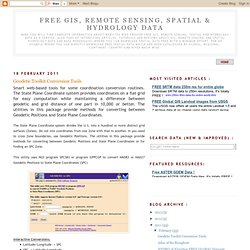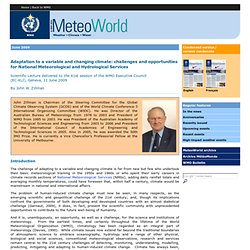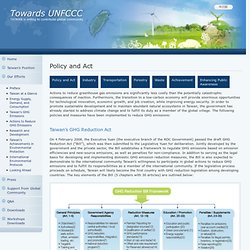

Youth@COP15 - The Youth Climate Movement's Coming of Age. February 2011. The World Digital Library (WDL) makes available on the Internet, free of charge and in multilingual format, significant primary materials from countries and cultures around the world from 8000 BC to 2009 AD and DOWNLOAD them in TIF and other known formats !

Type of Data/Materials Available Maps Prints, Photographs Books ManuscriptsMotion PicturesSound Recordings The principal objectives of the WDL are to: Promote international and intercultural understanding;Expand the volume and variety of cultural content on the Internet;Provide resources for educators, scholars, and general audiences;Build capacity in partner institutions to narrow the digital divide within and between countries.
Easy Drag & Navigable tool to locate the period, identify/select data and download The WDL makes it possible to discover, study, and enjoy cultural treasures from around the world on one site, in a variety of ways. The WDL was developed by a team at the U.S. Schwarze Pumpe Part 1: First Operational CCS Plant Captures Carbon, Will it Lead to “Clean Coal”? – Climate Protection – International Cooperation on Climate and Energy: This post is part of a special series of reports based on a recent trip to Germany as a guest of the Foreign Ministry to examine the country’s climate and energy policies - Rising up from the eastern German countryside at Spremberg near the Polish border, the two cone-shaped stacks stand as towering white monoliths jutting into the steel-grey sky.

Next to the large 1600 megawatt lignite coal-fired plant at Schwarze Pumpe stands a relatively small addition of tanks, towers, and pipes that comprise a 30 megawatt coal-fired boiler able to capture and ready to store its carbon emissions using Carbon Capture and Storage (CCS) technology. The purpose of the 30MW Schwarze Pumpe plant is to demonstrate the technology. As a test facility it does not contribute power to the grid. Vattenfall sells the steam generated that would otherwise turn a power-generating turbine to a neighboring paper mill.
Search Results: climate, page 1 - Maps and Graphics at UNEP/GRID-Arendal. The GRID-Arendal Maps & Graphics Library is an on-going project to collect and catalogue all graphic products that have been prepared for publications and web-sites from the last 15 years in a wide range of themes related to environment and sustainable development.

There are currently 3022 graphics available in the database. Biodiversity threats. S Journal of Sustainable Development. 4.

Advances in Integral Human Development If you could raise one question, what would it be? 5. Advances in Integrated Sustainable Development 6. 7. 8. 9. MDG Summit on 20-22 September 2010 in New YorkUN Millennium Development Goals, UN, 2008 Millennium Development Goals Report, UN, 2009Millennium Development Goals Indicators, UN MDG Database, 2010 Keeping the promise:A forward-looking review to promote an agreed action agendato achieve the Millennium Development Goals by 2015, UN Secretary General, 2010Global Civil Society Consultation for the MDG+10 Summit, UN March 2010. Climate Change. Governments recognize the importance of coordinating their climate change adaptation plans with disaster risk reduction measures.

They also recognize that these policies should be incorporated into their development and poverty eradication programmes. Managing the Risks of Extreme Events and Disasters to Advance Climate Change Adaptation (SREX) Recognizing the links between disaster risk reduction and climate change adaptation, the Intergovernmental Panel on Climate Change (IPCC) has undertaken a Special Report on "Managing the Risks of Extreme Events and Disasters to Advance Climate Change Adaptation (SREX). " This report, due out in 2011, will help policy-makers evaluate options for reducing disaster risks related to climate change. Newsletter: MeteoWorld. Adaptation to a variable and changing climate: challenges and opportunities for National Meteorological and Hydrological Services Scientific Lecture delivered to the 61st session of the WMO Executive Council (EC-XLI), Geneva, 11 June 2009 By John W.

Zillman Introduction The challenge of adapting to a variable and changing climate is far from new but few who undertook their basic meteorological training in the 1950s and 1960s or who spent their early careers in climate records sections of National Meteorological Services (NMSs), adding daily rainfall totals and averaging monthly temperatures, could have foreseen that, within half a century, climate would be mainstream in national and international affairs.
And it is, unambiguously, an opportunity, as well as a challenge, for the science and institutions of meteorology. Indeed, the WMO community can take great credit for having recognized, very early in the piece, and having drawn global attention to both: Improving responses through interlinkages in Africas policy. JI: Workshops / Side Events. Date: 9-10 September 2008Venue: UN Campus Bonn, "Langer Eugen" Hermann-Ehlers-Str. 1053113 BonnGermanyVenue locationDirections (subway) The UNFCCC secretariat is preparing the fifth UNFCCC workshop on joint implementation (JI), to be held in Bonn, Germany, on 9-10 September 2008.

The workshop is intended to allow the Joint Implementation Supervisory Committee (JISC) to consider the experiences of the applicant independent entities (IEs), and other involved stakeholders, to date, in particular with regard to matters directly of concern of the JISC in its supervision of the verification procedure under the JISC (JI Track 2 procedure). The first day of the workshop will be dedicated to interactions between the JISC and applicant IEs to discuss, based on their experiences, issues of particular interest. On the second day of the workshop some of these issues, as well as others concerning the JI Track 2 procedure, will be discussed by all participants.
Call for public input Presentations. 091203-engel-big-9a_1200.jpg (JPEG Image, 1200×849 pixels) - Scaled (74%) Urbanism 3: Adaptation. Adaptation to Climate Change in Developing Countries Climate change increasingly brings serious threats to the livelihoods, safety, poverty reduction and future economic development prospects of the poorest and most vulnerable areas of the world, the developing countries.

As the majority of developing countries are in tropical and sub-tropical regions, these areas are likely to be seriously impacted by climate change. Large areas in Asia, Africa, Latin American and the Small Island States (ie Mauritius) have been identified by the United Nations, the World Bank and other international agencies as among the most vulnerable regions. Foundation for a Low Carbon Future: Essential Elements of a Copenhagen Agreement. Insights for the Future from the Change of Climate in Copenhagen. OK – really truly everything you wanted to know about innovation (and probably some things you didn’t)… Posted by Matthew Lockwood Ryan from Australia has pulled us up on the last post, saying it is mistitled: “You have listed a number of interesting and promising developments, but in the end you have said very little about innovation itself.

How does innovation actually work?” Our titles are supposed to be witty rather than literal, but in the spirit of following through, this post goes into some of the thinking about the innovation process, and also why we need innovation policy for mitigating climate change. Tackling climate change needs technology policy because just correcting the externality of carbon pollution will not, on its own, induce the amount of innovation in low carbon technology that we will need.
There is another set of market failures involved, to do with companies not being able to capture all of the gains of their R&D, meaning that companies will not innovate enough on their own. Take another example from offshore wind. Like this: Like Loading... A framework to diagnose barriers to climate change adaptation.
In the first decade of the 21st century, adaptation to climate change has risen sharply as a topic of scientific inquiry, in local to international policy and planning, in the media, and in public awareness ( 1 – 3 ). Adaptation researchers have generally assumed lower vulnerability and greater adaptive capacity in developed countries than in developing countries and thus have focused more research in the latter ( 1 , 4 ). Yet climatic events in Europe, the United States, and Australia in recent years have also led to critical questioning of richer nations’ ability to adapt to climate change ( 3 , 5 , 6 ).
Bioenergy news. Taiwan into United Nations Framework Convention on Climate Change(UNFCCC) Actions to reduce greenhouse gas emissions are significantly less costly than the potentially catastrophic consequences of inaction.

Furthermore, the transition to a low-carbon economy will provide enormous opportunities for technological innovation, economic growth, and job creation, while improving energy security. In order to promote sustainable development and to maintain abundant natural ecosystems in Taiwan, the government has already started to address climate change and to fulfill its duty as a member of the global village. The following policies and measures have been implemented to reduce GHG emissions: Taiwan’s GHG Reduction Act. Corinair. CORINAIR - The New Family Of Software Tools Air Emission Data Exchange Module - project Within the framework of the Corinair - CORe INventory AIR emissions, the European Environment Agency (EEA) and its European Topic Centre on Air and Climate Change (ETC-ACC) have developed a set of software tools to support European countries in compiling annual air emission inventories.
Clean Development Mechanism. Introduction to the UNFCCC and its Kyoto Protocol. UNFCCC process. United Nations Framework Convention on Climate Change. The United Nations Framework Convention on Climate Change (UNFCCC) is an international environmental treaty negotiated at the United Nations Conference on Environment and Development (UNCED), informally known as the Earth Summit, held in Rio de Janeiro from 3 to 14 June 1992. The objective of the treaty is to "stabilize greenhouse gas concentrations in the atmosphere at a level that would prevent dangerous anthropogenic interference with the climate system".[2] The treaty itself set no binding limits on greenhouse gas emissions for individual countries and contains no enforcement mechanisms.
In that sense, the treaty is considered legally non-binding. Instead, the treaty provides a framework for negotiating specific international treaties (called "protocols") that may set binding limits on greenhouse gases. Towards sustainable construction: promotion and best practices. Framework for developing a municipal adaptation plan. This article originally appeared in Tiempo Issue 87 April 2008 By Pierre Mukheibir and Gina Ziervogel Introduction In recent years, reducing vulnerability to climate change has become an urgent issue in low- and middle-income countries, and is at the forefront of any sustainable development policy agenda.
Adaptation to climate change is a process whereby individuals and communities seek to respond to ‘actual or expected climatic stimuli or their effects’. This process is not new and throughout history, people have adapted to changing climate conditions. National Adaptation Plans of Action (NAPA) have been developed recently under the United Nations Framework Convention on Climate Change (UNFCCC) for Least Developed Countries (LDCs). This article presents an overarching framework developed for a municipal level approach to adapting sectors to climate impacts. 15 Global Challenges. The 15 Global Challenges updated annually continue to be the best introduction by far to the key issues of the early 21st century. -- Michael Marien, editor, Future Survey 15 Global Challenges facing humanity. Mother Pelican ~ A Journal of Sustainable Human Development. The Green Business System. Biochar Farms. In physical terms, biochar is simply the charred remains is formed when plant material is heated in an oxygen free environment–a process scientists call “pyrolysis.”
Unlike charcoal which is very similar, biochar is created specifically to improve soil structure and ehnance crop productivity. “Net energy,” or the total amount of energy yielded from the process, is positive meaning it generates more energy than it consumes.